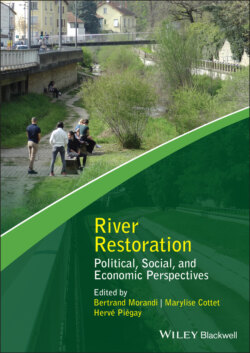Читать книгу River Restoration - Группа авторов - Страница 32
1.4.3.1 Contributions focused on the evaluation of benefits of river restoration
ОглавлениеThe financial amounts committed to river restoration are an important issue, highlighted by several reviews on river restoration (e.g. Bernhardt et al. 2005; Szałkiewicz et al. 2018). Some economic publications are more focused on project costs alone. Cost reduction is very often the objective of these studies, which take note of the strong budgetary constraints imposed on the implementation of restoration actions. This search for cost optimization leads some authors to question and prioritize the restoration techniques that are adopted in projects (e.g. Hill et al. 2011; Kristensen et al. 2012; Carah et al. 2014). Other authors look at costs from a different perspective, assessing costs as losses to the stakeholders in the restoration. At the heart of these studies is the value of the assets that certain stakeholders must give up if the restoration project is to be carried out; these are opportunity costs. For example, Gómez et al. (2014) consider the opportunity costs associated with the reduced power generation resulting from the implementation of flushing floods which are known to restore basic environmental functions in highly engineered rivers. In particular, they demonstrate that this cost is lower than the willingness to pay for such restoration measures. Losses are also sometimes considered in terms of the compensation to be paid to the stakeholders affected by the restoration project (e.g. Cheng et al. 2019). Such cost‐only approaches are not dominant in the literature.
The vast majority of the literature with an economic approach to river restoration compares costs against benefits or focuses on assessing benefits alone. In the cost–benefit analyses, it is above all the evaluation of benefits that is at the heart of the research effort. The costs are considered as fixed data that are not very open to discussion. Behind this interest in the benefits, there exists a form of engagement of the scientific community that is in favor of river restoration policies. By making visible the benefits induced by the projects and highlighting their effectiveness from the point of view of public investment, these publications help to justify and promote river restoration to decision‐makers and the general public. This focus on benefits can also be explained by the methodological challenges faced by researchers. While it is indeed relatively easy to access project cost data – at least for technical implementation – the measurement of benefits is more challenging (Brouwer and Sheremet 2017). This is all the more true because environmental benefits are most often of a nonmarket value that is difficult to measure. To determine this value, which some authors describe as a “shadow price” (e.g. Grossmann 2012; Becker et al. 2014), economics relies on a substantial methodological arsenal (see Box 1.4).
